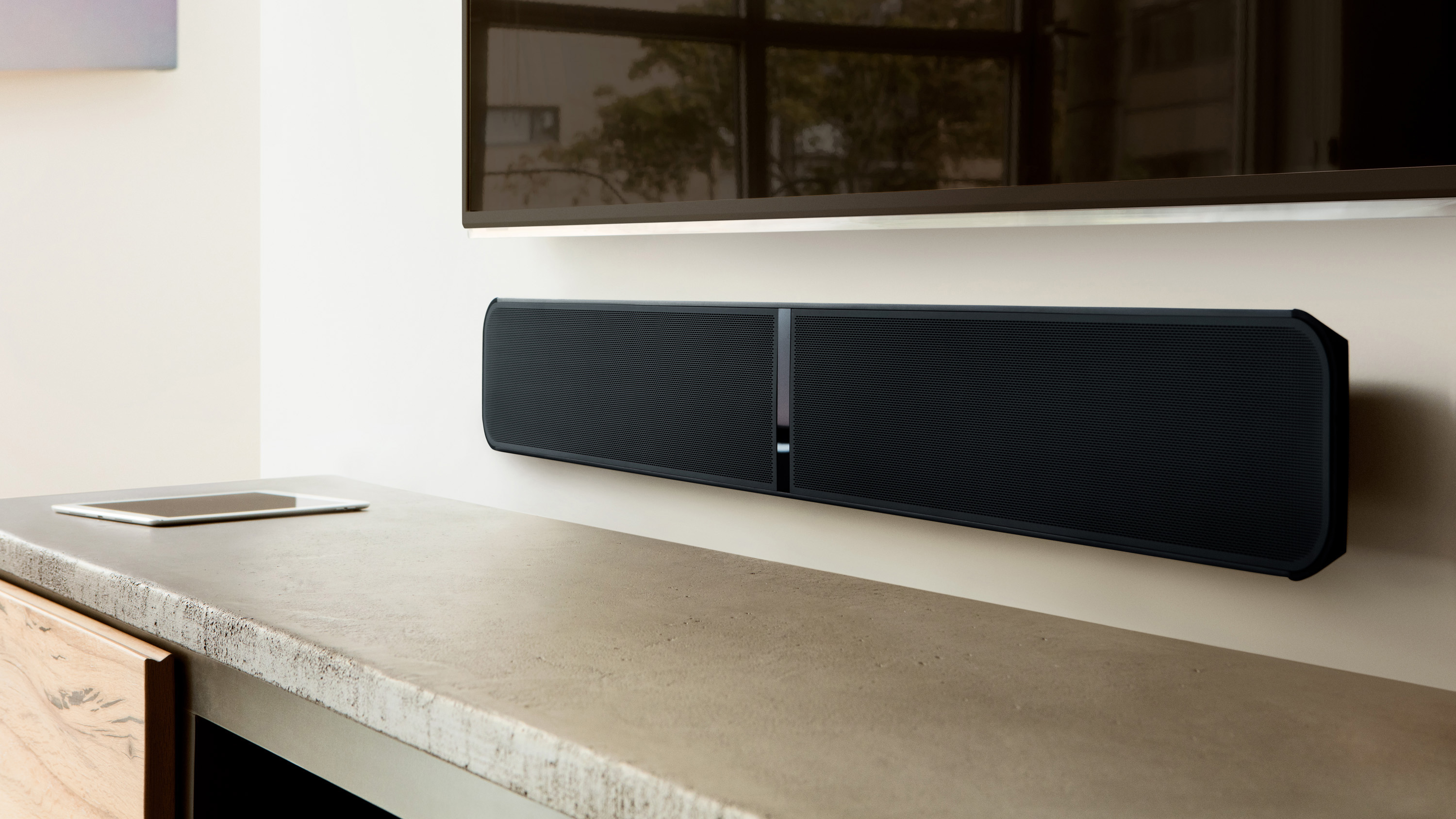TechRadar Verdict
Supporting 192kHz/24-bit lossless music, this multi-room networked soundbar impresses with warm and detailed sound, but it’s height makes it hard to install easily, and makes it feel like its a multi-room speaker in the shape of a soundbar rather than something that's been built from the ground up to sit underneath your TV.
Pros
- +
192kHz/24-bit quality
- +
Warm and precise sound quality
- +
Spotify, Tidal, Deezer & Amazon Music
- +
Excellent build quality
Cons
- -
Too tall for TV tables
- -
No HDMI inputs
- -
No remote control
- -
Manual network shares
Why you can trust TechRadar
Soundbars are everywhere, but at each end of the price range they could hardly be more different. Any cheap sounder can improve on the sound of your TV’s speakers, but the Pulse Soundbar does so, so much more.
Yes, it can take a feed from a TV (via optical audio/Toslink) and deliver a great movie soundtrack or dialogue-heavy TV show. It’s also recently been upgraded to handle Dolby Digital soundtracks. And like many mid-range soundbars it can stream audio from a tablet or phone via Bluetooth.
But as part of the Bluesound Pulse lineup, the soundbar is also a capable multi-room speaker in its own right, similar to the Sonos Playbar and Playbase. So how does it stack up to the multi-room incumbent?
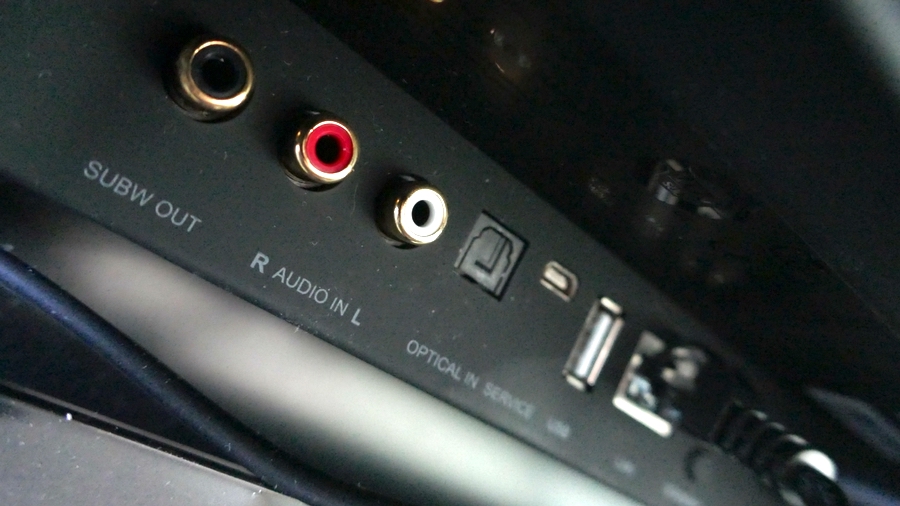
Features
The Pulse Soundbar is part of a collection wireless speakers that includes Bluesound’s Pulse 2, Pulse Mini and portable PulseFlex as well as the Pulse Sub and Vault 2 hard drive. Buy a couple of PulseFlex speakers and they can act as wireless rear speakers in a 5.1 surround sound system, with the Pulse Soundbar acting as a the centre, left and right channels.
Inside the soundbar itself are six 20W speakers (two soft-dome tweeters, two mid-range drivers and two passive woofers) powered by a DirectDigital amp.
There’s something else about the Pulse Soundbar that makes it standout from the crowd; streaming. However, as well as being able to stream music from the likes of Amazon Music, Spotfiy, Tidal and Deezer (and scores of others), it can stream lossless music in 192kHz/24-bit quality.
Admittedly, lossless and hi-res audio is something of a niche, and completely unknown to many, but with Tidal and Deezer both making moves to embrace the MQA codec, the library of easily accessible hi-res music is starting to slowly grow.
Selling in matte black or white for £999 (US$999 / AUS$1,799), the Pulse Soundbar measures 1073x141x70mm (and ships with a wall bracket), and weighs 6.8kg.

Set-up and performance
Although the core set-up procedure of linking the Pulse Soundbar to a home network via a phone works smoothly, there are some initial disappointments. The first is the rather bizarre 141mm height of the Pulse Soundbar, which makes it unsuitable for placing in front of most TVs. Not only was the grille pitched about an inch too high for our 50-inch TV, thus obscuring part of the screen, but in this orientation the connections panel is ranged upwards. Any attached cables (such as the power cable, optical audio and Ethernet LAN) poke out of the top.
The Pulse Soundbar is therefore best suited to hanging underneath a wall-mounted TV, and this appears to be no mistake; Bluesound also sells its TS100 Universal TV Stand, custom-made stand that lifts both the soundbar and a TV up to 65-inches in size. At $299, that’s an expensive heavy-duty workaround.
However, it’s focus on lossless audio and its pro-install design is perhaps not so surprisingly if you consider that the Pulse Soundbar’s control app, BluOS, also works with NAD amplifiers and streaming devices. It also plays nicely with custom install control brands URC, RTI and Control4.
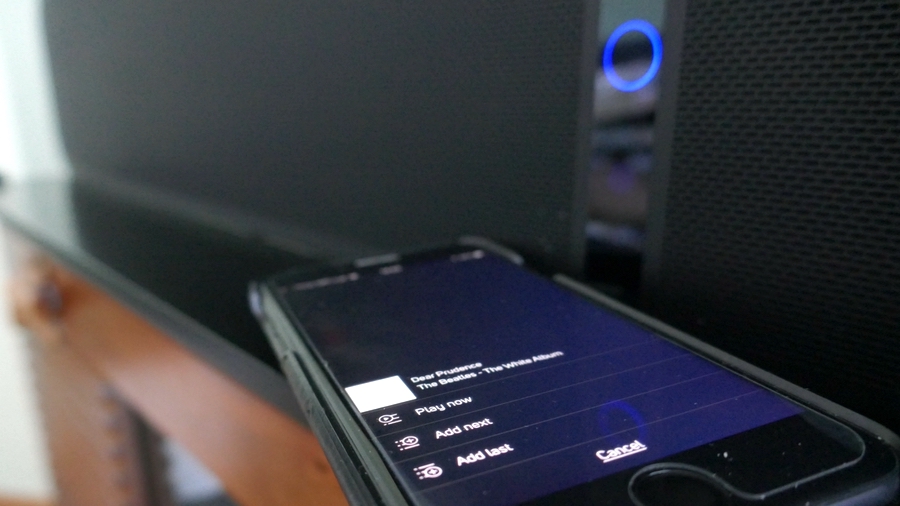
Whatever Bluesound’s target market, BluOS itself does a fair job of linking disparate sources together from a number of different platforms. It's available for iOS (including Apple Watch), Android and Kindle Fire, as well as in a desktop app for Windows and Mac.
It streams from connected accounts, but it also carries web radio streams, makes use of Bluetooth 4.0 (including aptX), and handles up to 192kHz/24-bit lossless music files such as FLAC, WAV, AIFF and MQA.
However, don't drop down to Bluetooth if you can help it. Yes, the Pulse Soundbar does a much better job with this poor man's wireless music than most routinely bad Bluetooth speakers, but there's a noticeable drop in width and detail.
Although the Pulse Soundbar can stream from a PC, Mac or NAS drive, it does so in a disappointingly manual way. Bluesound’s OS is bespoke and is built on a Linux platform, so has no third party middleware. The flip-side of that is that it's not compatible with DLNA and UPnP devices, so sharing with a PC, Mac or a NAS drive means setting-up a manual network share – and it's not just a case of browsing the network and selecting the music folder. In our test it proved a little too time-consuming, which is a shame because the BluOS app gives the impression that it will be easy.
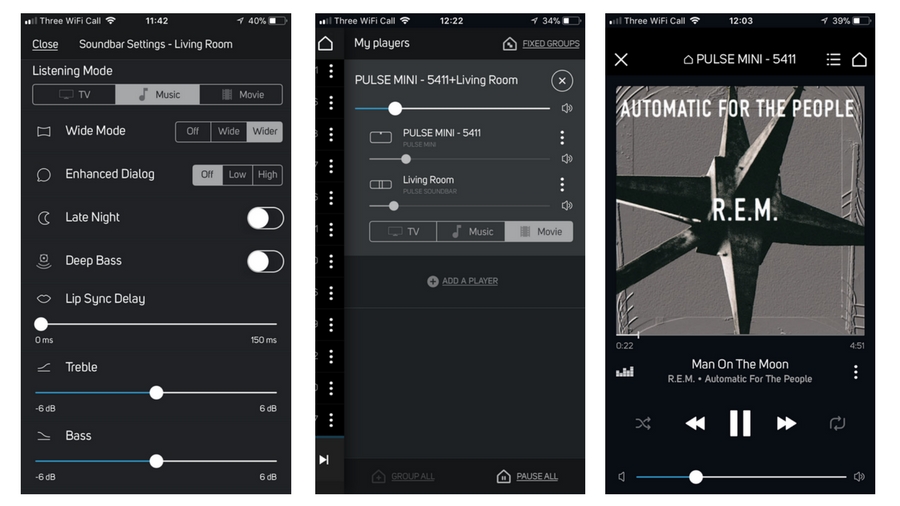
The BluOS app is similar to the Sonos equivalent, though small thumbnail versions of album cover art often get confused, which makes it difficult to swap between zones at-a-glance when more than one Bluesound product is installed. However, the multi-room aspect of the Bluesound concept works very well; we were able to ‘carry’ songs between rooms, play songs simultaneously in several rooms, and play two different playlists on two different speakers with ease.
And when it comes to sound quality, the Pulse Soundbar does really impress enough for a ‘wow’ moment. Oddly, it’s necessary to go to the source page and put the Pulse Soundbar into either TV, music or movie mode, but each one is a fairly well-judged preset.
Straight out of the box the soundstage for movies is warm and detailed, although the vocal track does have a tendency to get lost. Cue a page of tone settings in BluOS, which present a couple of effective options for enhancing dialogue. There are also tweaks for ‘deep bass’ and a ‘late night’ volume decreaser. The lip sync delay adjuster is a nice touch, too, though aside from a simple treble and bass tweaks, there’s little to adjust. No matter, because the stunning soundtrack and chilling effects of Stranger Things on Netflix were rendered exceptionally well.

Music also impresses with its overall warmth and the detail within treble peaks, with the otherwise rather pointless ‘wide mode’ bringing forward some background detail. It’s best to keep ‘enhanced dialogue’ engaged for clear vocals, and ‘deep bass’ is also worth keeping a trigger-finger on.
However, for a concept so proud of its lossless music streaming capabilities, the app fails to let you know exactly what quality you’re streaming in. However, if you do subscribe to the likes of Tidal HiFi and Deezer HiFi, you do see a tiny ‘hifi’ icon. Basically, the Pulse Soundbar plays whatever you chuck at it – and it does it all very impressively.
Here's a great-sounding speaker that's far far more capable than your average soundbar, and yet there's enough quirks for it to be a specialist purchase.
We liked
We've no complaints about the warm, mellow and yet incredibly precise sound that the Pulse Soundbar lends to both music and movies despite not having much in the way of customisation options.
The ability to stream, via one app, tunes from myriad streaming services is very welcome (those apps include Amazon Music, Calm Radio, Deezer, Groove Music, JUKE, KKBOX, Murfie, Napster, Qobuz, Radio Paradise, Slacker, Spotify, Tidal, TuneIn and WiMP). The multi-room aspect also worked well.
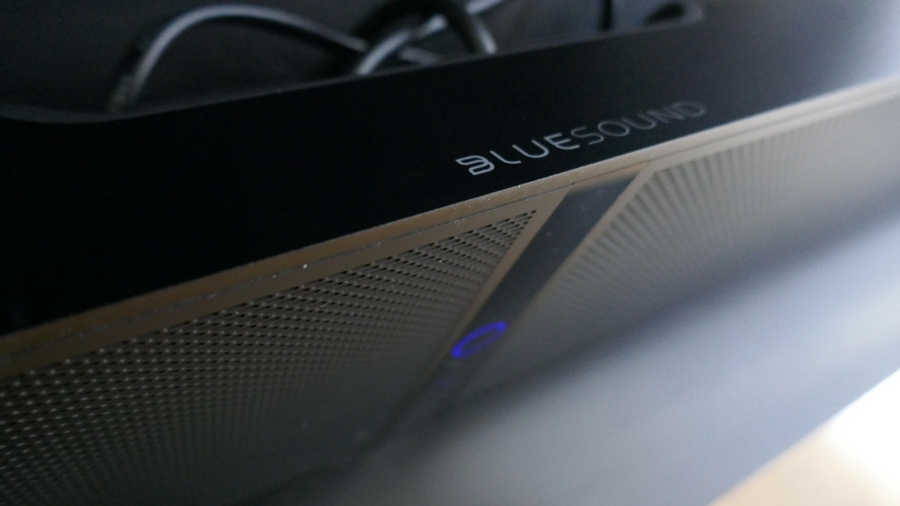
We didn't like
All soundbars wanting prime place in a living room must offer HDMI switching, and the nascence of any HDMI inputs on the Pulse Soundbar makes us think of it as an oddly-shaped hi-fi.
Our impression of it as having a confused design is underlined by its frankly bizarre height, which makes it obscure the screen if placed in front of a TV. Is the Pulse Soundbar only meant to be hung under a wall-mounted TV? Perhaps so, because placing in front of a TV is also likely to block your TV’s remote sensor.
Yes, there is an option to teach the app to learn the IR commands of your TV's remote, but that just adds to the admin that setting-up the Pulse Soundbar already demands. Setting-up network share with a Mac or PC is a hurdle most won’t overcome, and what’s more, the BluOS app is often vague.
It also has a penchant for flashing-up error messages when a connection goes awry; one one occasion, it flashed-up six error messages in a row.
We were also rather annoyed that I had to manually put the Pulse Soundbar into music, TV or movie mode each time I swapped.
Final verdict
Although it dazzled us with its sound quality across the board – from compressed TV audio right through to lossless music streaming – the Pulse Soundbar just fails to be the home cinema hub it could have been.
A multi-room network audio player that can fetch streams from anywhere, its lack of HDMI switching, manual network shares and odd design (that sees it block the view of a TV it’s placed in front of) takes a little of the shine from the otherwise intriguing and impressive Bluesound concept.
- For our top soundbar picks, our guide to the best soundbars has everything you need
Jamie is a freelance tech, travel and space journalist based in the UK. He’s been writing regularly for Techradar since it was launched in 2008 and also writes regularly for Forbes, The Telegraph, the South China Morning Post, Sky & Telescope and the Sky At Night magazine as well as other Future titles T3, Digital Camera World, All About Space and Space.com. He also edits two of his own websites, TravGear.com and WhenIsTheNextEclipse.com that reflect his obsession with travel gear and solar eclipse travel. He is the author of A Stargazing Program For Beginners (Springer, 2015),
